How to Use a Long Leash for Dog Training: 11 Tips
- Anja Boecker
- Updated: 2023-05-31
You and your good-natured dog are a well-coordinated team, but as soon as you find yourselves at a distance, it's over with the artfulness? If you want to do something about it, I recommend long leash training.
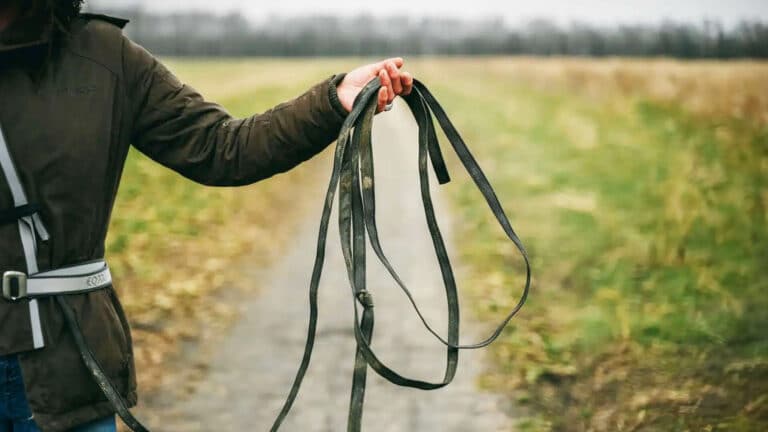
Few things can break the bond between you and your dog. ♡
However, unleashed dogs may occasionally run away while walking.
They decide for themselves under what circumstances they will return to their mistress or master. Or they want to decide for themselves where to go.
Especially dogs with a strong hunting instinct prefer to follow their instincts in nature. They simply run at certain stimuli.
In this case, dragging training can be beneficial for both of you. It teaches your pet that you are in charge, even from a distance. So your dominance is not only at home, but outside as well.
In this article, we will give you easy-to-understand information and tips about the dragline. This is what you should keep in mind during your training. Enjoy reading! 😊
What is a long leash?
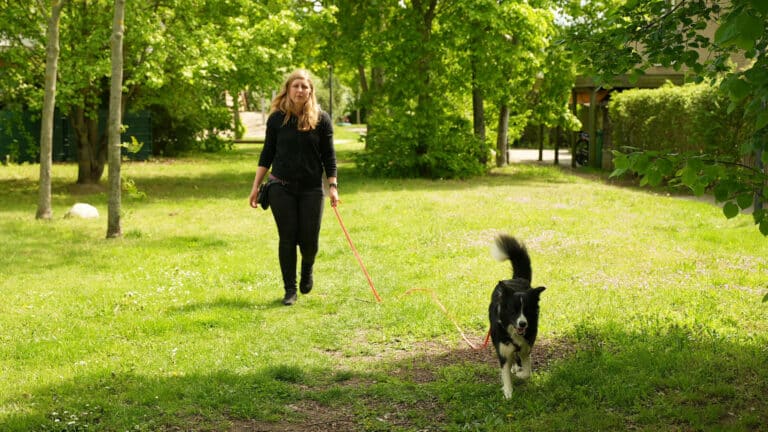
A long leash is actually a regular leash. However, it is longer than a normal leash. It is usually between 5 and 15 or even 20 meters long.
The long leash do not have any other eyelets or the like, except for the possibility of attaching them to the chest harness. This prevents the eyelets of the line from getting caught in a branch, for example.
You can use a leash to train commands. Your pet must perform the command at a certain distance from you, such as coming back to you.
The long leash is mainly used for dogs that have a strong hunting instinct due to their breed. They learn to obey commands from an early age, even when they are far away from their owner.
The long leash is also often used when the dog is forced to be on a leash. However, the dog should have enough room to run and roam. The handler always has the option of stopping the dog from a distance.
Long leash training is most effective when the dog's hunting instinct is not yet developed.
He should also know basic commands such as sit, stay, etc. Ideally, he should be used to a conventional leash. He needs to understand that the leash is not a toy.
Difference Between a Leash and a Long Leash
The difference between a normal leash and a long leash is the length and the purpose of use:
- Length: A regular leash is usually between 1.2 and 2 meters long and is used to guide the dog in close proximity. A drag leash is longer and can be between 5 and 15 meters long. A long leash allows your dog to get farther away from you while still keeping him under control.
- Usage: A regular leash is typically used in everyday life to keep your dog close to you while walking, training, or in public. It gives you some control and allows you to guide your dog safely.
A long leash, on the other hand, is often used in training, especially in recall or radius training. It gives your dog more freedom of movement and allows him to move farther away from you, while still allowing you to control him or call him back if necessary.
It is important to note that a drag line is not recommended for everyday use in busy or crowded areas, as the length of the line can cause tangles or safety hazards. The drag line is primarily used as a training tool in controlled environments.
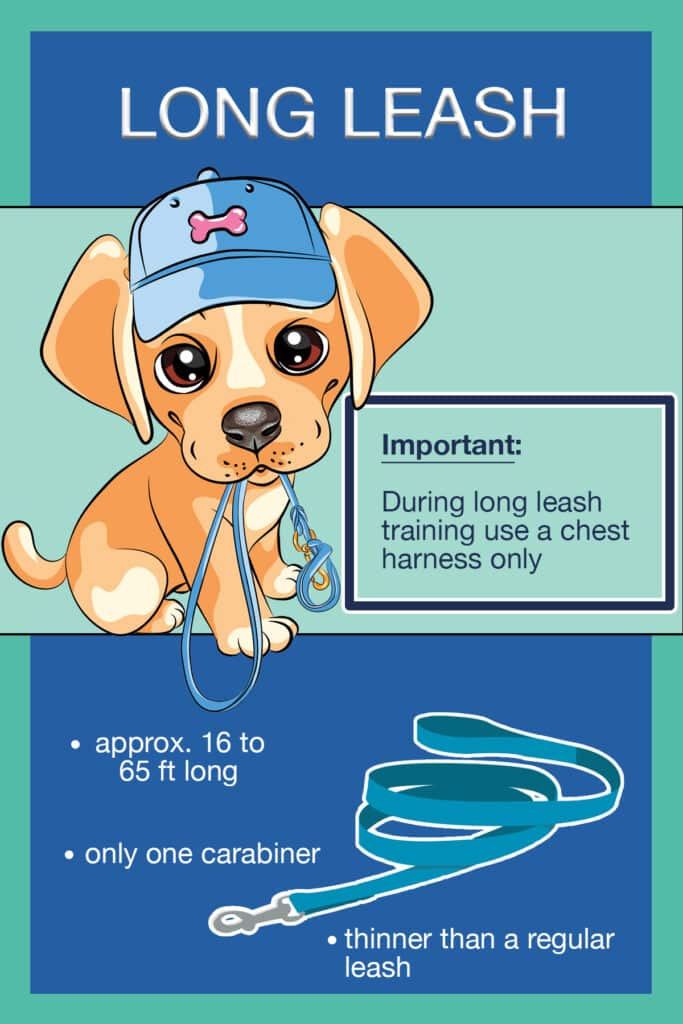
Why Keep the Dog on a Long Leash?
1) Very Effective on Puppies
Because of their age, drag line training is most effective with young dogs. This age is characterized by puberty. This means that they are particularly energetic during this time.
Sexual maturity sets in and the hormones go crazy. The hunting instinct also comes out at this age. In short, the young dog is in a period of testing his limits.
A dog's hunting instinct generally begins between the ages of 4 and 5. However, this can vary from breed to breed and even from individual to individual.
The goal is to control this drive at a young age and get the dog used to coming back when called.
2) Useful for Unruly Dogs
You may be at the end of your rope because your furry friend simply does not obey.
You can also use leash training in these situations. This training gives you more control over your pet.
Unfortunately, adult dogs are often more difficult to train. You may want to consider hiring an experienced dog trainer.
3) A Must for Hunting Dogs
Some breeds have a strong hunting instinct. They instinctively pursue anything they perceive as prey. This is why they will ignore their owner's call.
For these breeds, it is recommended to work toward this consistently from puppyhood. Control the hunting instinct.
4) Leash Requirements Allow Long Leashes
A long leash can also be a good compromise to the leash requirement. Dogs need enough space to run and move around while still being tethered.
With a long leash, they have the freedom to explore their surroundings without restriction. Your favorite can run without you having to worry about whether or not he is listening to your commands.
It has a larger action radius and you maintain control over it.
5. During Training
You need a long leash for radio training and recall training to ensure your dog's safety. The tug line gives you control over your dog while allowing him to move freely. It is used to give your dog more freedom while still being able to stop him in case of an emergency.
The long leash helps you slowly acclimate your dog to longer distances without letting him escape. It allows you to gently and carefully call your dog back if he gets too far away.
The long leash is especially important if your dog is not yet a reliable recaller. It allows you to control your dog and protect him from potential danger. The long leash is a tool to ensure a positive and safe learning experience for your dog.
It allows you to gradually intensify your training and build confidence.
The long leash is a temporary tool you use during training to give your dog freedom while keeping him safe.
7 Benefits of Using a Long Leash for Training
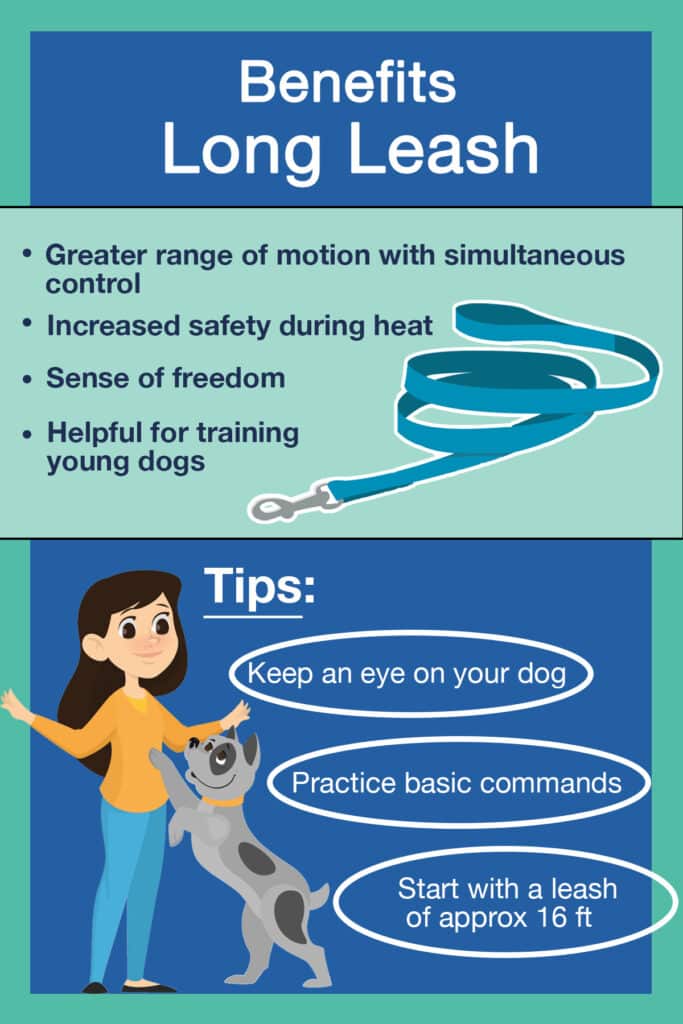
- Reduces undesirable hunting behavior
- Leash training is improved
- Ideal training method for puppies
- Dogs can run free in places where a leash is required.
- Hazards such as poisoned bait are easier to avoid.
- Control your pet from a distance
- You can more confidently train your dog to come when called.
What Length of Leash Do I Need?
The most important features of a towline are material and length.
1) The Length
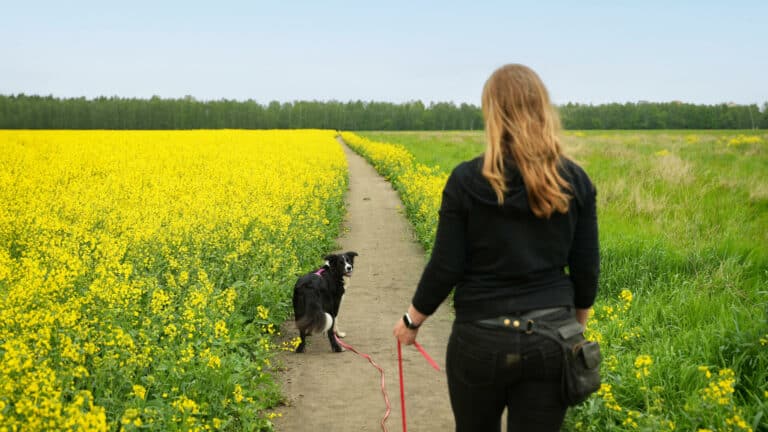
How long should the long leash be?
To start, we recommend a length of about 5 meters. A larger radius will overwhelm you and your dog in the beginning.
Have you both gotten used to the radius? Do you have good control of the leash? Does your dog listen to your commands within 5 meters? Then you can move on to a longer leash.
Optimum is 10 to 15 meters. Longer leashes are also available. Keep in mind that the longer the line, the greater the risk of injury in dangerous situations.
You should also make sure that the leash is properly sized for your pet's weight and size.
I'm sure you can imagine how much pull a large dog can have when running at full speed. With a very long leash, he would be difficult to stop and the risk of injury to both of you would be too great.
2) The Material
The most common materials for these leashes are greased leather, biothane or nylon.
Many users swear by the grip and suppleness of greased leather. It will not cause painful burns if the leash slips out of your hand. It also does not knot as easily.
As long as the surface is well treated, it will not absorb too much mud and water in adverse weather conditions. This also prevents the line from becoming too heavy.
However, oiled leather has a drawback:
Greased leather must be regularly treated with leather grease and cannot be washed. When treating with grease, dosage is important.
If you use too much grease, the leash can easily slip out of your hand. Long fat leather leashes are in the upper price range.
Biothane material is tear resistant, flexible and maintenance free. It does not absorb mud or water. Adhering dirt is easily rinsed off with water.
The wipes are also available in signal colors. They are soft to the touch.
It should be noted that some Biothane leashes are a bit more slippery. Biothane long leashes are mid-range in price.
Long nylon leashes are also available in rubberized and non-rubberized versions. You may want to choose the rubberized version.
They are lightweight, washable, and quick-drying. However, most are not water repellent. Once they absorb water, they become quite heavy.
Leashes are available in signal colors. They are in the lower price range.
No matter what material you choose, make sure the leash is strong, tear resistant and has a good grip.
It is always advisable to wear gloves. This will prevent abrasions, etc.
How Should I Use a Long Leash for Training?
For starters, it is recommended that you purchase a leash that is approximately 5 meters long. Of course, this also depends on the weight and size of your dog.
As a rule of thumb, the bigger and stronger your pelt, the shorter the leash should be. It takes time to get used to a long leash.
You can hold the leash or let it leash along the ground. Either pull the leash or step on the leash with your foot to make your dog stop. This also takes practice.
11 Tips for Leash Training
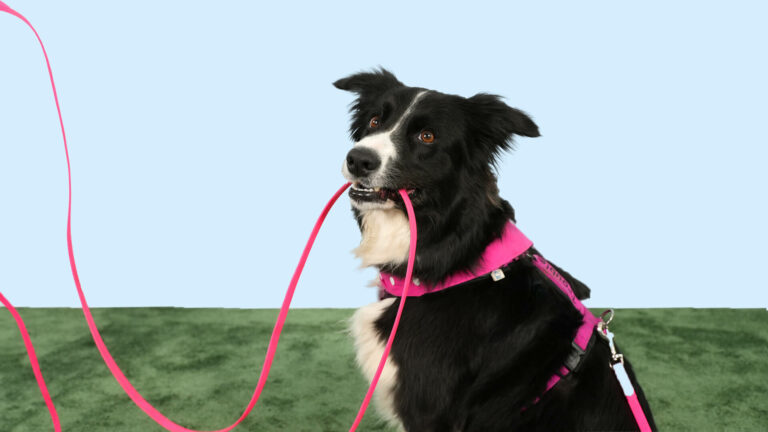
1) Use a Leash Only With a Harness.
You should always use a chest harness when using a drag line. This is important. A regular collar can cause injury to the cervical spine in the event of a jerky pull.
Tip #2: The Length of the Leash Must Be Adjusted to the Size of Your Dog.
Always make sure the length of the leash is appropriate for your dog's weight or size. The heavier or stronger your pet is, the "shorter" the leash should be. The optimal length for beginners is about 5 meters. After some practice, the length can be increased to 10 to 15 meters. This will depend on the size and weight of your dog. Make sure the width of the leash is optimal. Narrower or thinner leashes are better for small breeds.
Tip #3: Use Signal Colors
Signal colors should be used for the leash color if possible, so that the long leash can be seen by others. Signal colors are especially useful in the dark or in bad weather conditions. A strong orange, green or pink with a neon look is optimal.
Tip #4: Wear Slip-Resistant Shoes and Gloves
Especially in wet weather, it is advisable to wear non-slip shoes. If you have to step on the leash to stop your dog, the risk of slipping is greater with non-slip shoes. You should also wear gloves. This will prevent abrasions and burns on your hands. In case the leash slips out of your hand.
Tip #5: A Quiet Place Is Best for Getting Started
When you first start training, it is best to go to a quiet place. Quietness is important so that your dog is not exposed to too many stimuli. This will help him concentrate on the training.
Tip #6: Always Ensure Leash Training First
Long leash training is used to improve the dog's ability to walk on a leash. However, the long leash should only be used when the dog has certain basic skills. Otherwise, burns, joint problems, or other injuries may result. We therefore recommend that you first get your dog used to a "conventional" leash.
Tip #7: Basic Commands Should Already Sit
It is advisable that your cat already knows the basic commands. If not, it will be more difficult for you to teach her these commands from a distance. Also, you should be able to use these commands safely when working with the long leash.
Tip #8: Always Praise Well
Praise plays an important role in dog training. That's why it's important to use praise even when training with lures. Whether you give your dog a treat, a pet, or verbal praise is up to you. The important thing is that the praise comes immediately after the correct action.
Tip #9: Patience, Patience and More Patience
Patience is always important, so it should always be used when training on a leash. Under no circumstances should the leash be jerked for disobedience. Loud scolding is also not recommended. The leash should never be used as a punishment. Communication between you should be calm and consistent. This will prevent your pet from developing a negative relationship with the leash.
Tip #10: Do Not Let Your Dog Play With Other Dogs on a Leash
Especially with tug leashes, make sure your faithful companion is not romping around with other dogs. There is too much risk of the leash wrapping around the dog as it plays. Also, the leashes can get tangled if the playmate is also on a leash.
Tip #11: Always Be Mindful
You must be very careful when using a long leash and understand the risks. If your dog jerks off, the leash can wrap around your feet and cause you to lose your balance.
2 Long Leash Exercises
Exercise # 1: Recall Training With the Long Leash
- Begin training in a safe, enclosed environment.
- Attach the long leash to your dog's harness.
- Let your dog pull the long leash behind you while you hold the leash.
- Take a few steps back and call your dog to you in a friendly and firm manner.
- Use positive reinforcement, such as praise or a reward, when your dog responds to your call and comes to you.
- If your dog doesn't respond immediately, gently tug on the long leash to get his attention.
- Repeat the training regularly and slowly increase the distance between you and your dog.
- Avoid punishing your dog or pulling harshly on the long leash as this can affect your dog's confidence and motivation.
- Use distraction-free environments to begin training, and gradually increase the distraction as your dog responds more reliably.
- Over time, you can gradually shorten the long leash or remove it altogether if your dog responds reliably to the recall.
Remember that recall training takes time and patience. Be consistent, positive, and reward your dog for good behavior.
Exercise # 2: Long Leash Radio Training
- Begin exercising in an enclosed area, such as a fenced yard or court.
- Attach the long leash to your dog's harness.
- Let your dog pull the long leash behind you while you hold the leash.
- Walk slowly to the edge of the demarcated area.
- Make sure the leash is loose and allows your dog to move freely.
- When your dog reaches the boundary of the demarcated area, call him back to you in a friendly and firm manner.
- Use positive reinforcement, such as praise or a reward, when your dog responds to your call and comes to you.
- If your dog doesn't respond immediately, tug gently on the long leash to get his attention and bring him to you.
- Repeat the training regularly and slowly increase the radius in which your dog is allowed to move freely.
- Gradually introduce distractions such as other dogs or people to get your dog used to responding to your call in stimulating situations.
- Use the long leash to teach your dog to stay close to you and not to cross the established boundary.
Over time, you can shorten or eliminate the leash if your dog reliably stays within the established radius.
It is important to be patient and build up the training gradually. Reward your dog for good behavior and be consistent in your demands.
Frequently Asked Questions
It is normal for puppies to pull on the leash as they are still exploring. When older dogs pull on the leash, it may be due to lack of training, breed, stress or too short walks.
If your dog starts to pull, you should stop immediately until he stops. If he does not stop, walk in the opposite direction. Under no circumstances should you pull your dog backwards.
In general, harnesses are preferable because they are much gentler than collars. Due to the better weight distribution of the harness, the neck vertebrae are relieved compared to the collar.
A long leash is actually a regular leash. However, it is longer than a normal leash. It is usually between 5 and 15 or even 20 meters long. Long leashes do not have eyelets or anything like that, except for the possibility of attaching them to the chest harness.
The long leash is particularly suitable for young dogs, unruly dogs, breeds with a strong hunting instinct and as a compromise for dogs that need to be walked on a leash.
My Conclusion
The drag line and drag line training have their advantages. That is why they are mainly used for the Anti-hunting training used.
➡ This way your dog will learn to obey your commands even from a distance.
Would you like to give your dog a larger run despite the leash restriction? This can be, for example, in a green area or in the forest. The drag line is a good compromise here.
As long as you follow the recommendations and take the necessary steps, a drag line can take you a long way in your training.
It provides a lasting and healthy connection between you and your dog. If the distance between the two of you is ever greater than usual, a drag line is a good solution.

My name is Anja Boecker, and I am a certified dog trainer and behavior consultant. With these articles, I want to help you to understand your dog better and to build an inseparable bond.
Share Now:


I have read the blog post and must say that it is very informative. I also liked the writing style. Keep up the good work and publish more content. Cheers!